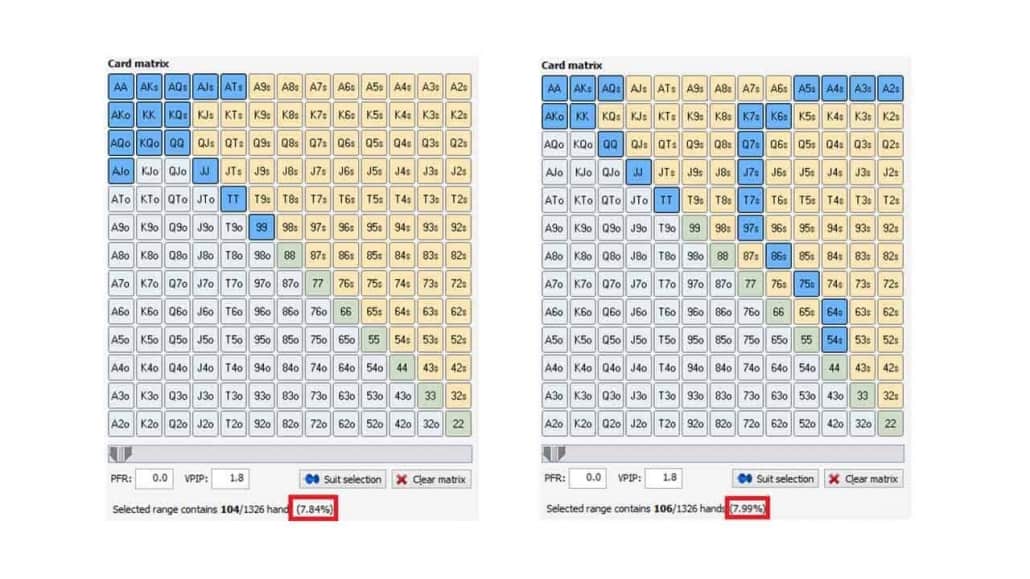Essential Poker Statistics – How To Win More By Mastering Your Stats

13 minutes
Last Updated: March 19, 2024
In today’s modern poker environment, the game has evolved almost to the point of science. Best players out there take a very methodical approach to the game and utilize every piece of information they can get to beat their opponents and improve their win rates.
Poker statistics play an important role in this setup. Generated over large samples of hands through software such as Holdem Manager or Poker Tracker, these numbers can tell you a lot about other players’ tendencies and their leaks. They can also help you improve your own game.
However, for this information to be useful, you need to learn what the most important poker stats are and how to read them correctly. Without knowing this, these are just numbers on the screen that don’t help you at all.
So, in this article, I will try and dissect some of the vital statistics in poker that you can find in pretty much any tracking software.
By the time you’re done reading, you should understand not just the meaning of these different numbers but also have an idea of what they should look like for optimal results.
Preflop Poker Stat #1: VPIP – Voluntarily Put Money ($) In Pot
It is one of the most basic stats there is, and while it may not tell you a lot on its own, it can be a pretty good indicator of someone’s general tendencies.
The acronym stands for “Voluntarily Put Into Pot,” i.e., it covers all the times you willingly put any chips in the pot by choosing to play the hand.
Every time you make a raise, call someone’s raise or limp along, your VPIP increases. Only the chips you post when in the blinds don’t influence this poker statistic as these are counted as mandatory bets. You can’t choose to skip the big or the small blind and continue playing.
There is no single number for VPIP that could be defined as correct because it largely depends on your playing style. Looser players will naturally be on the higher side of the spectrum, while TAGs tend to have lower VPIP.
In general, the VPIP for a solid winning player will fluctuate between 20% and 30% for short-handed games.
In full-ring, it will be anywhere between 14% and 22%.
Preflop Poker Stat #2: RFI – Raise First in
The RFI poker stat is closely related to VPIP, as winning players tend to play a large percentage of their hands as either a raise or a fold.
Of course, this isn’t always the case as you’ll still be defending from the blinds some percentage of the time or call against a 3-bet. Thus, RFI is always lower than the VPIP.
So, as the name suggests, this stats tells you how often the player raises when they’re first into the pot (i.e., everyone before them had folded). Like the rest of the stats, it is calculated based on the number of actual opportunities you had to raise first in, which doesn’t happen on every hand you play.
For a winning player, the RFI stat will usually be in the 20-30% range.
Anything above 30% is usually too aggressive, and the number significantly below 20% indicates you’re probably not raising enough when you have the opportunity to do so. It can be a bit lower for full-ring games.
Preflop Poker Stat #3: 3bet
The 3bet poker statistics can tell you a lot about how aggressive your opponent is in general. It describes how often they come over the top when facing a preflop raise.
Once again, keep in mind that the stat is calculated based on the number of actual opportunities and not all the hands' someone has played.
So, if someone has a 3bet of 20%, this means that every fifth time someone raised and it was folded to them, they decided to raise instead of calling or folding (1 out of 5 hands).
On average, a winning player will have a preflop 3bet percentage of anywhere between 3% and 6% for the full ring.
In short-handed games, this poker stat will naturally go up and will be more in the 4.9% to 8.9%, at least at low to middle stakes. At higher stakes, the 3bet stat tends to be slightly higher in general as these games play more aggressively.
Of course, if you want to gain deeper insights into someone’s 3bet tendencies, you’ll need to look at the breakout by positions. Usually, if someone’s getting out of line, they’ll be doing it from the button or maybe from the blinds.
Preflop Poker Stat #4: Fold to 3bet
You want to see your statistics in this area because it is one of the most common mistakes.
Many players are folding too much to 3-bets, making them very vulnerable to any aggression.
You will not win much by folding, so learn how to play postflop and start defending more. Folding more than 60% to 3bets is a huge mistake.
If you find yourself in this spot, you should reduce the number of your opening hands or call/4bet more when facing a 3-bet, especially when you have a position on your opponents.
Preflop Poker Stat #5: Fold to Steal
A good chunk of your poker winnings will come from uncontested pots and stealing blinds with antes. The poker term commonly used to describe this is “stealing,” and although it may sound sinister, it is a perfectly acceptable part of the game.
In terms of poker stats, steal is any raise in an unopened pot coming from late positions, namely cutoff, button, and the small blind. And the “Fold to Steal” stat defines how often a player in the big blind folds to such attempts.
While it is impossible to play profitably from the blinds, it is essential to master skills to help you better defend against aggression.
Folding over 70% to steals is a significant leak in your game, and if you recognize it with other players, you should be attacking their blinds as often as you can.
In fact, in today’s modern games, with the average raise size being smaller, you’ll probably want to defend against steals even wider. It will inevitably put you in some tricky postflop spots, but you can’t afford to fold away your equity in the blinds.
—
Quite a few other poker statistics are covering the play from the blinds, mostly how much you call or 3bet from the BB. You want to look at BB call vs. SB open, BB 3bet vs. SB open, BB call vs. BTN open, and so on, you get the drill.
Blinds’ play is surely one of the most important areas because you are forced to play every hand when you are in the blinds, no matter what you get. You cannot fold without investing anything like from other positions, so finding your mistakes, if you have any, in this specific area will save you a lot of money.
You also should understand other statistics in poker, such as squeezing, isolating vs. limpers, and much more. Before moving to the postflop area, be sure to fix your preflop play.
The same kind of analysis could be made for postflop stats. Of course, it is far more complicated as things get more complex once the flop is out, but you surely need to understand the basics.

Postflop Poker Stat #1: Cbet Flop
C-betting is a huge topic on its own. You do not want to be c-betting too much and then be folding almost always when you check. It is a bad strategy but unfortunately used very widely.
You want to check some strong hands to bluff catch on later streets, and you want to balance your ranges having the right amount of bluffs and value hands when you bet. You can learn more about this by studying the GTO poker strategy.
In general, you’ll want to keep your Cbet Flop stat around 45% – 60% as part of your solid strategy.
You can increase this frequency in the lower stakes games to exploit weaker players because they tend to fold too much. In this particular area, you’d rather err on the side of aggression.
Postflop Poker Stat #2: Fold to Cbet
If you’ve read the above paragraph, you know that a good player will likely be c-betting with a fairly wide range of hands on the flop. What this means is that you need to adjust to this tendency and not over-fold to their continuation bets.
You need to realize that you do not need to be right all the time when calling. For example, if your opponent bets ½ pot on the river, you only need to win 1 out of 4 times to be breaking even. Therefore, if you think you are winning more than 25% of the time, this is an easy call.
Do not be fooled by people shouting out that players do not bluff so much, or that they do not bluff on lower stakes. They do! Of course, you have to pick your spots and put the opponent on a range, but as long as you are doing that, trust these poker statistics, and you will be good!
In terms of numbers, your Fold to Flop Cbet should be in the 40% to 60% area.
The actual decision in the hand depends on the sizing because of the bigger your opponent bets, the more you should fold, but that is a separate topic. If you want to learn more, take a look at this article about poker odds to learn the numbers.
A good way to adjust is to fold more against players with a lower c-bet percentage and those with lower VPIP in general as these players will tend to have a stronger hand when they get involved. By the same token, you don’t want to be folding too much against aggressive players.
Postflop Poker Stat #3: Cbet Turn
This poker stat describes the frequency with which the player who was the last raiser before the flop bets the turn.
This bet is made when the initial raiser already has some idea about the strength of the opponent’s hand (they called the flop c-bet, for example), and they still choose to continue betting.
For a winning player, this stat tends to fluctuate between 45% and 65%.
Of course, this doesn’t mean that this poker statistic alone (this or any other) will make you a winner, but these are the numbers displayed by the winning players across a large sample of hands.
Postflop Poker Stat #4: Went to Showdown (WTSD)
WTSD is an important statistic that tells you how often you (or your opponent) get to the showdown once you see the flop.
A number that’s too low indicates that you’re probably folding too often at certain points in the hand. A number that’s too high indicates that you’re likely too sticky and get to a showdown with some hands you should be folding.
A solid winning player will have a WTDS poker stat between 21% and 32.5%.
If you find your WTSD is higher than this, you should be looking to lower it by decreasing your overall RFI / VPIP stats (i.e., playing fewer hands), tighten your river calling range, or try to find some folds on earlier streets where you don’t feel as committed to a hand.
Postflop Poker Stat #5: Won Money at Showdown (W$SD)
W$SD poker stat describes the number of times you end up winning any money at a showdown. It doesn’t have to be a net positive, i.e., you could win less than what you had invested into the pot, but you still ended up winning some money when cards were turned over.
In general, a high W$SD stat indicates a strong, competent player. A lower number can be an indicator of a non-sophisticated opponent who bluffs too often or tends to make some light calls.
The number analysis shows that winning players usually have a W$SD stat of around 52% to 66%.
So, more than half the time they go to showdown, they end up winning money. If you’re below 50%, some things you can do to increase your WSD include bluffing less frequently, calling with tighter ranges on the river, and improving your general understanding of other players’ ranges to avoid calling off lightly.
Postflop Poker Stat #6: Aggression % by street
Many players are struggling to keep up the aggression. Even if they play preflop and flop quite well, unfortunately, they tend to be more passive on later streets.
This is quite bad, and you want to have at least 30% aggression on every street, not just on the flop because of the high c-bet poker stat.
If you are far from that, quite likely, you are missing some value and should be betting and raising more instead of just calling or checking back.
Postflop Poker Stat #7: River Call Efficiency
This poker stat can give you a lot of information on how effectively you are calling on the river.
If the value is lower than 1, you surely have a problem and call too many weak hands on the river.
However, if it is very high (more than 2), you are likely missing some calls on the river and folding too much. That could be a big problem as well.
To find some of your potential mistakes, I highly recommend filtering out this spot in your tracking software. If you don't have one, get a FREE trial of Holdem Manager or Poker Tracker.
![]()
Make sure to go over the spots where you call on the river holding a weak hand, and see if you could find some folds there. To take it even further, filter out hands where you fold to river bet and see if you could call in a few more spots as well.
How Understanding Poker Statistics Will Help You Win More
Analyzing your poker statistics is always a moving target, and you need to put in a lot of work to stay ahead of your competition. While there are many more poker stats to analyze, you should start with the previously mentioned ones and take advantage of available poker tools to work on your game.
Of course, you should start with preflop stats. Jumping straight to the postflop would not make much sense. As long as you are making mistakes, preflop, you have no chance of playing solid strategy on later streets, so let’s cover it first.
While learning poker rules and getting poker cheat sheets can help you instantly improve your stats, it will not be enough if you want to have serious results.
Consuming random content is also not the best option, so you either can join one of the best poker training sites or do all the work yourself.
If you ready to put in the hours, you can learn to analyze your game and understand poker stats yourself.
If you have no idea what to do – start by looking at the best players in your games. Filter out their stats, and compare them to yours in different spots, and you will have a good understanding of how they play. Quite likely, it will reveal your potential mistakes, and then you can concentrate on fixing it one by one.
Just before jumping into it, I want to mention the free poker app that you can use to play around with your ranges – Equilab. Using it, you can easily visualize how that % of your poker statistics looks in reality. You can see that your 3bet range of 8% could include different variations of hands, depending on your opponent.

So make sure to play around with this tool and build a better understanding of various poker statistics and your opponent's ranges.
The Most Important Part Of All Poker Stats And Statistics
Identifying and fixing your mistakes is vital, but poker stats can help you more than that. If you ever wondered what the best way to take advantage of your opponents is, well, only the poker statistics of a particular player can show you the answer.
Now you know what the range for the most important stats in the game is, and whenever you see someone deviating from those, you can adjust your strategy and win even more money.
Thus, always take poker statistics very seriously and observe your opponents both in live and online games.
Fun fact: only 5% of poker players are winning in the long run, and only 1% are crushing the games with huge returns.
If you want to be one of the best, take the poker quiz and find the fastest way to success!






















